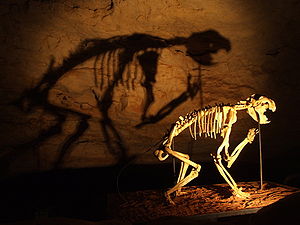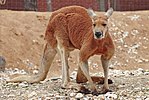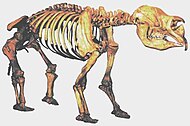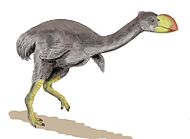澳洲巨型动物群
外观

澳洲巨型动物群是一些澳洲的大型动物,一般体重在30公斤以上,或比其现存亲属重30%以上。大部份澳洲巨型动物群都已于更新世灭绝。[1]
澳洲巨型动物群灭绝的成因现正研究中。有指是因人类约于4.8-6万年前的到来,猎杀及使用火来管理环境所致。[2]于1.8万年前最高峰的冰期令环境干旱可能也是成因之一。不过澳洲巨型动物群在突然消失前,已经生存了达200万年,期间也有出现干旱的冰期。根据光释测年及铀-钍测年的最新证据,人类可能就是澳洲巨型动物群灭绝的主因。[3]所有形式的巨型动物群都是于同一时期(约于4.7万年前)内灭绝,正好人类首次到达澳洲。从巨型动物群牙齿的氧及碳同位素分析,显示一场突然及大型的非气候事件,改变了植被及现今有袋类的食性,且令巨型动物群灭绝。研究进一步发现当时的气候与今天的干旱情况无异。
史前的澳洲巨型动物群与一些传说生物有很多相似的地方。
现存的巨型动物群
[编辑]哺乳类
[编辑]
- 红大袋鼠:是非常大型的袋鼠,身上有红褐色的短毛。雄性高1.8米及重85公斤。雌性高1.1米及重35公斤。尾巴可以长达1米。
- 东部灰大袋鼠:分布在澳洲南部及东部,高2米及重66公斤。
- 羚大袋鼠:分布在澳洲北部。
- 岩大袋鼠:分布在多种的环境,如森林、沙漠及草原。它们重15-47公斤,高1.3米。
- 袋熊:分布在澳洲东部及塔斯曼尼亚的温带森林及高原,重约25-40公斤。
- 毛鼻袋熊:只重19-32公斤,较袋熊粗壮,四肢短小。
- 澳洲野犬:狼的亚种,约于4000年前被引入到澳洲。重约13-20公斤。[4]
鸟类
[编辑]
- 鸸鹋:羽毛柔软,毛色通常都是啡色。身高由1.5至2公尺,体重约45公斤,最多不超过60公斤,而雄鸟的体型通常较为细小。
- 鹤鸵:居住于新几内亚及东北澳洲大型不会飞的鸟,约1.5-1.8米高,有些甚至可达2米高,体重为60公斤。
爬行类
[编辑]
1788年前灭绝的巨型动物群
[编辑]单孔目
[编辑]- 哈克特默里舌鼹:于西澳大利亚州的洞穴内发现,至今也是单孔目中体型最大的。
- 迪氏顽齿鸭嘴兽:长60厘米的鸭嘴兽,其化石于里弗斯利(Riversleigh)发现。
- 拉氏巨针鼹:前肢非常强壮,主要吃蠕虫及蛆。
- 硕巨针鼹:另一种巨针鼹。
有袋类
[编辑]
- 丽纹双门齿兽:是双门齿科中最大的物种,也是有袋类中最大的,差不多有3米长,肩高2米及重达2吨。
- 小双门齿兽
- 三叶大面颊兽:约有2米长。它们栖息在湿地,以叉状的门齿铲起芦苇及莎草科作为食物。
- 阿氏袋貘:与大面颊兽大小相近,爪及鼻子都很长,生存于中新世。
100-1000公斤
[编辑]- Euowenia grata:欧氏兽的一种。
- Nototherium mitchelli:南袋兽属的一种。
- 宽颧弓兽(Euryzygoma dunense)
- Phascolonus gigas:大袋熊属的一种。
- Ramsayia magna:拉氏袋熊的一种。
- Procoptodon goliah:巨型短面袋鼠的一种,是最大的袋鼠,高2-3米及重230公斤。
- Procoptodon rapha、P. pusio及P. texasensis:巨型短面袋鼠下的物种。
- 平面袋鼠:是一属巨型的沙袋鼠。[6]
- Palorchestes parvus:袋貘的一种。
- Macropus pearsoni及M. ferragus:大袋鼠属的物种。
10-100公斤
[编辑]- Simosthenurus pales:短鼻粗尾袋鼠属的一种。
- 丁氏强袋鼠、Sthenurus oreas、S. andersoni及S. atlas
- 巨型树袋熊:比现今的树熊大上三分之一。
- Phascolomys medius
- Lasiorhinus angustioens:毛鼻袋熊属的一种。
- 和谐袋鼠
- Troposodon minor:褶齿袋鼠属的一种。
- 小型短脸袋鼠:与现今的东部灰大袋鼠一样高,但较为粗壮。
- Simothenurus brownei、S. gilli及S. maddocki
- 食肉袋鼠:生存于中新世及上新世,重达70公斤,高1.5-3米。它们的牙齿显示是肉食性的。
- 刽子手袋狮:大小如豹。
- Vombatus hacketti:袋熊属的一种。
- Macropus thor、M. piltonensis及M. rama:大袋鼠属的物种。
- Warrendja wakefieldi
- Sarcophilus harrisii laniarius:袋獾属的一种,外观像放大了袋獾。
鸟类
[编辑]
- 史氏雷啸鸟:一种不会飞的鸟,高3米及重500公斤。
- Bullockornis planei:一种牛鸟,高2.5米及重250公斤,很可能是肉食性的。
- 牛顿巨鸟:与驼鸟差不多高,是驰鸟科最后生还的成员。
- Leipoa gallinacea是一种巨型的眼斑冢雉。
爬行类
[编辑]
- 古巨蜥:是一种巨型及肉食性的巨蜥,可能长达7米及重1940公斤。[7]
- Wonambi naracoortensis:一种无毒的沃那比蛇,长5-6米。
- 金卡纳鳄属:马氏鳄亚科的鳄鱼,长5-7米。
- 沼王鳄属:马氏鳄亚科的鳄鱼,体长可达4米。
- 岩蟒属未知物种:生存于上新世,长达10米,是已知澳洲最大的蛇。其外观很像奥立弗蟒。[8]
- 卷角龟:是一属巨型的陆栖曲颈龟亚目,长2.5米,头上有角及尾上有刺。
1788年后灭绝的物种
[编辑]
- 袋狼:已于1936年消失,正式确认于1989年灭绝。
- 塔斯曼尼亚鸸鹋:确实灭绝的时间不详,可能是于1850年。
- 袋鼠岛鸸鹋:确实灭绝的时间不详,可能是于1827年。
- 王岛鸸鹋:于1822年灭绝。
- 东部小袋鼠:最后的标本是于1889年纪录的。
- 荒漠袋鼠:最后于1935年见到。
- 荒漠袋狸:最后的标本是于1943年纪录的。
- 新月甲尾袋鼠:最后的标本是于1928年纪录的,于1956年灭绝。
- 宽脸长鼻袋狸:最后的标本是于1875年纪录的。
- 图拉克袋鼠:于1939年灭绝。
- 豚足袋狸:约于1950年代灭绝。
其他大型澳洲物种
[编辑]
传说的巨型生物群
[编辑]参考
[编辑]- ^ Josephine Flood. Archaeology of the Dreamtime. Marleston: J.B Publishing. 2004: 182. ISBN 1876622504.
- ^ Miller, G. H. Ecosystem Collapse in Pleistocene Australia and a Human Role in Megafaunal Extinction. Science. 2005, 309: 287–90. PMID 16002615.
- ^ Prideaux, G.J.; et al. An arid-adapted middle Pleistocene vertebrate fauna from south-central Australia. Nature. 2007, 445: 422–5.
- ^ L.K. Corbett. Australian and Oceania (Australasian) (PDF). [2009-10-05]. (原始内容 (PDF)存档于2008-05-28).
- ^ Flannery. T Pleistocene extinctions as cited in Josephine Flood (2004) Archaeology of the Dreamtime, J.B Publishing, Marleston p. 178 ISBN 1-876-62250-4
- ^ Helgen, K.M., Wells, R.T., Kear, B.P., Gerdtz, W.R., and Flannery, T.F. Ecological and evolutionary significance of sizes of giant extinct kangaroos. Australian Journal of Zoology. 2006, 54: 293–303. doi:10.1071/ZO05077.
- ^ Molnar, R. Dragons in the Dust: The Paleobiology of the Giant Lizard Megalania. Indiana University Press. 2004: 127.
- ^ Scanlon JD and Mackness BS. A new giant python from the Pliocene Bluff Downs Local Fauna of northeastern Queensland. Alcheringa. 2001, 25: 425–37.
- Field, J. H. and J. Dodson. 1999. Late Pleistocene megafauna and archaeology from Cuddie Springs, south-eastern Australia. Proceedings of the Prehistoric Society 65: 1-27.
- Field, J. H. and W. E. Boles. 1998. Genyornis newtoni and Dromaius novaehollandiae at 30,000 b.p. in central northern New South Wales. Alcheringa 22: 177-188.
- Long, J.A., Archer, M. Flannery, T.F. & Hand, S. 2003. Prehistoric Mammals of Australia and New Guinea -100 Million Years of Evolution. Johns Hopkins University Press, Baltimore. 242pp.
- Murray, P. F. and D. Megirian. 1998. The skull of dromornithid birds: anatomical evidence for their relationship to Anseriformes (Dromornithidae, Anseriformes). Records of the South Australian Museum 31: 51-97.
- Roberts, R. G., T. F. Flannery, L. A. Ayliffe, H. Yoshida, J. M. Olley, G. J. Prideaux, G. M. Laslett, A. Baynes, M. A. Smith, R. Jones, and B. L. Smith. 2001. New ages for the last Australian megafauna: continent-wide extinction about 46,000 years ago. Science 292: 1888-1892.
- Wroe, S., J. Field, and R. Fullagar. 2002. Lost giants. Nature Australia 27(5): 54-61.
- Gavin J Prideaux, Richard G. Roberts, Dirk Megirian, Kira E. Westaway, John C. Hellstrom, John M. Olley. 2007. Mammalian responses to Pleistocene climate change in southeastern Australia. Geology, v. 35, n. 1, p. 33-36.
